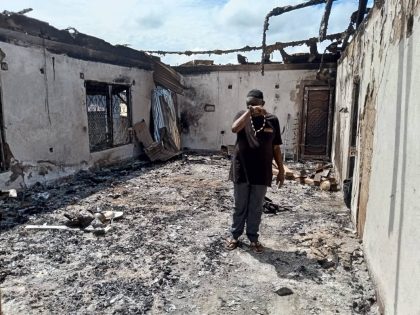The people of Blikkiesdorp
Photographer Lizane Louw chronicles the people of Blikkiesdorp, a temporary relocation camp on Cape Town's Cape Flats.

Ouma Magdalena by Lizanne Louw. Courtesy of the photographer.
For at least 3 years now South African photographer Lizane Louw have chronicled the lives of the people of Blikkiesdorp (translation: Tin Town), a temporary relocation camp in Delft, not to be confused with the Dutch town but one of the poorest townships in Cape Town. It is located about 30 km from the city center.
Life in Delft consists of daily humiliation for the camp’s residents who face no, or little, protection from violent crimes, rape and robberies. Some residents, though, have organized themselves. For the city, run by the Democratic Alliance, the camp is at once a temporary and permanent solution to housing problems. Lizanne speaks of the city planning to erect another 200 structures in Blikkiesdorp.
Lizanne decided to photograph residents of Blikkiesdorp 2 years ago. In February this year she wanted to publish some of the pictures, including one of a 92 year old grandmother, Ouma Magdalena. When she went back to ask Ouma Magdalena for permission to publish the image, she found the old woman had passed away. She had TB.
“Ouma is a big inspiration for this project that I am currently doing. I would like to use her story to make a change in this community. I don’t think it is ethically and morally acceptable that people that are poor must live in such challenging and substandard living conditions. Something needs to be done and we need to seriously reflect on ourselves as a society, when these things happen in your backyard without us attempting to do anything about it."
All the photos are available on the project's Facebook page. Here Louw describes some of the photographs:
“The photograph [of Ouma Magdalena] is one of the first I took in Blikkiesdorp. The name “Tin Town” comes from these rows and rows corrugated iron structures that make up the streets and community in Blikkiesdorp. This is a very special photograph. Ouma Johanna walking in one of the alleys in Phase 1. The green dress that she wore that day was her favourite. When I met her, she was sitting outside her structure and she smiled. She said that she knew she had to put on her favourite green dress, because that day was going to be going to be a special day. I smiled and enjoyed following her and photographing her in Blikkiesdorp. Ouma Johanna passed away in 2010. She died of starvation.”
[Photo]
“Blikkiesdorp has a moon landscape, there is no color, no solid structures, no plants, grass or trees. When I first started photographing there it looked to me like a metal tin-town. I understood the name it was given by the community ‘ Tin Town’ or in Afrikaans “ Blikkiesdorp”. The “architecture” is changing as more people are moved in and more structures are build. And yes, it is becoming another shanty town.
In one photo children wear makeshift raincoats and throw up gang signs:
[Photo]
“This saddened me from the very beginning. Gangs, 28’s and 27’s, are the role models in this society. It is very rare that you would find children that would not pose without giving you a “nommer” (“number”; meaning a gang sign). This is the reality and if you ask them about it they will share their stories and their understanding. They don’t know anything better. However, what I find inspirational about Blikkiesdorp is that the people always use creative ideas to overcome obstacles, the “raincoat” is a good example of this. These “raincoats” are made out of plastic bags they pick up in the garbage bins. These garbage bins are an endless source of entertainment for the children. They also make kites out of these garbage bags. This is what they do. It is normal to them. Some of them even make their own “raincoats” when they go to school …”
[Photo]
“This is Adeen and Anton. I have not seen Adeen (left) for about a month. Anton applied for and received his first disability grant at the end of May and left Adeen in Blikkies. I plan to visit her soon. From this news, I gather that their “engament” is off and also the wedding her mom, Tannie Elna, was dreaming about.”
[Photo]
“There is no form of recreation for any of the 7,500 children. The children and teenagers make toys out of anything they pick up. Here, the group build a table from stuff that they found. Dominoes is a very popular game in Blikkies[dorp]. Most evenings and during holidays, people can be found playing dominoes in the streets.”



















